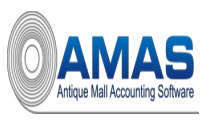The story of AMAS
In 1985 the owner of Antique World, located in Meyerland Plaza, Houston Texas, contacted us. Scott was looking for a solution for his twice-monthly nightmare of having to pay his 80 or 90 Antique Dealers. They were spending about 20 man-hours TWICE each month tabulating approximately 3000 tickets.
The process involved making multiple copies of every invoice, one copy for every item on the ticket. Invoice copies were then placed into pigeonholes or stacks for each dealer. Once the invoice copies were sorted, each dealer’s stack of invoices had to be listed and tabulated at least twice, sometimes more. Next commissions, credit card fees, sales taxes, rents and advertising fees had to be manually deducted. Once the final figures for each dealer were processed, the Net Check amount for each Mall Dealer could be added to the batch list. The final figures had to be compared with the period’s total sales or cash receipts. Once everything checked out, checks had to be written by hand. This whole process was long, tedious, and absolutely guaranteed to hide more calculation errors than the average tax return.
About this time in my career, I had about 5 years programming experience, but that was mostly on Main Frame writing in COBOL. In 1983, the IBM PC was only 2 years old and I managed to purchase my first PC for about $3500 (no hard drive – only 2 floppy drives), the dot matrix printer was another $1000. I was intrigued with this new program called dBase2 and luckily they released dBase III before I started writing the Antique Mall Accounting System. It took about 5 or 6 months to finally get a working version for the Antique Mall to start using. I think I may of delivered the program right before our Wedding in April 1986.
After AMAS was up and running for a about a year, we sold a second system in Dallas, eventually 2 more systems to the Antique World people. By 1994 we had sold 100 systems. Only 13 of those first 100 stores are still in business today. At least three of those stores have been passed down to a younger generation in the family.
In 1988, AMAS was converted to a more robust database program named Clipper TM from Nantucket Software. Nantucket is long gone, but we still have several dozen customers still running on this 20+ year-old DOS version of AMAS. It still works great today, but each successive version of Windows makes it difficult to hang on. Eventually these customers have to let go of their 20 year-old computers and move on to our Windows version of AMAS.
In 1999 we made a deal with Antiqueland USA that eventually added more than 30 stores that included six Craft Malls acquired in 2002. In the mid 2000’s Antiqueland filed bankruptcy, many stores closed or sold to 3rd parties.
In 2000 we added our Mall Dealer online services what-sold.com and mall-info.com. Dealers could now logon from a computer anywhere in the World at any hour to check on their sales progress. Mall personnel no longer have to spend hours on the phone every Monday researching and reading sales reports over the phone to their dealers.
In 2000 we also moved AMAS to the Windows world using Microsoft Access as our platform. Many of our customers were extremely reluctant to give up the DOS version of AMAS, and few dozen holdouts still refuse to let go.
In 2020 we started moving most of our customers to version of AMAS running on MS-Access 2016/2019.
More than 36 years ago we started out in the Antique Malls, Consignment stores and Craft Malls. We still get a lot of new Antique Malls and not quite so many Craft Malls these days. Over the past 15 years we have added number of Home Decor Malls and a number stores with multiple locations. Since 2005 we have been adding a lot of Boutiques.
In late 2022 we plan to update our what-sold.com website in order to enhance the dealers experience and provide additional access to information.
Bruce Lowry
Designer, Analyst & Programmer of AMAS
